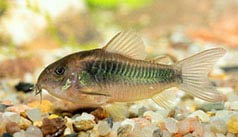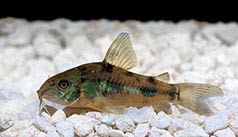

Rabaut’s cory
(Corydoras rabauti)
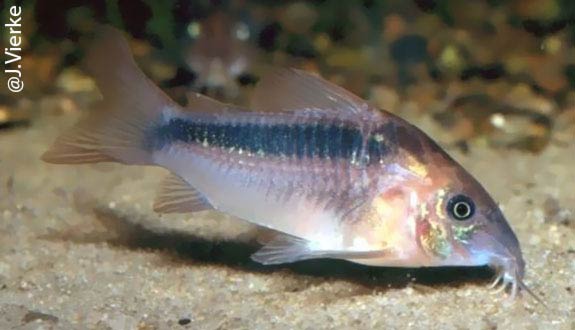
Thanks to Kyllian. As stated by Horlack's scientific article
> read
Alternative species (click on the thumbnail to see the card)
Names
Scientific name
Corydoras rabauti
Corydoras meyersi
Corydoras myers
Common name
Rabaut’s cory
Rust corydoras
Origin

Origin: Peru, Brazil
Biotope: Amazonian
Dimorphism
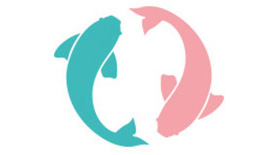
The female is larger and more robust than the male
Group
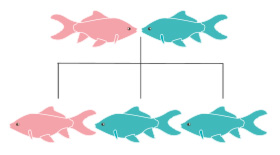
Callichthyidae
Volume

80 L / 18 imp gal / 21 US gal
Parameters

T°: 22 to 26°C or 72 to 79°F
pH: 6.5 to 7.2
Hardness: 4 to 15°dGH
Difficulty

Easy
Size

4.5 to 5.5 cm (1.8 to 2.2")
Longevity

2 to 5 years
Living zone
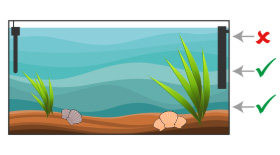
Middle and depth
Individuals

6 or more
Food
How to feed this Corydoras?
Food
How to feed this Corydoras?
Corydoras rabauti is omnivorous, that is to say it accepts a wide variety of food, be it carnivorous or vegetal.
Bottom pellets sold commercially (and flowing to the bottom of the aquarium) will make a good feeding base.
Complete with regular contributions in vase worms (which they love!), daphnies, tubifex, artemia and in plants such as cucumbers, zucchini, poached or boiled spinach, peas... Remove uneaten food at night.
If your fish are hungry, they are not eating enough! If your Corydoras are struggling to eat because other fish in the aquarium are faster, distribute their meal when the lights go out and watch if your Corydoras eat well.
Behavior
What kind of behavior does this Corydoras have?
Behavior
What kind of behavior does this Corydoras have?
It is a quiet and peaceful ground-fish, sometimes even a little fearful. It has a fairly developed gregarious instinct and requires group maintenance, otherwise it is stressed and worried.
It will frantically search the sand in search of Its pittance. During the day, it will meet with its peers to rest, sometimes even to pile on each other. Finally, you will see him having fun in the current in the middle part of the aquarium or along the windows (if no species intimidates them).
If your Corydoras are completely inactive during the day, it may be due to a problem of cohabitation (other species intimidate them), a too small number of individuals, an unsuitable aquarium or a current too weak. Check these points and you will see your Corydoras activate even during the day!
Even if the corydoras are very fearful, you can, with gentleness and patience, accustom them to your presence. For this, you must always make very slow and very calm gestures. When your corydoras do not flee you, it denotes a level of fulfilment, security and confidence well above normal!
Cohabitation
Who can live with this Corydoras?
Cohabitation
Who can live with this Corydoras?
Do you know that Corydoras form groups of thousands of individuals in their natural environment? In aquarium, it is therefore necessary to reproduce on a smaller scale this exceptional sociability. The bare minimum will be 6 individuals, but the more there are, and the happier they will be! Regarding this point, it is estimated that:
group of 6 to 8 individuals: strict minimum
group of 9 to 13 individuals: correct viability
group of more than 14 individuals: behavior similar to natural
You can choose this species as part of a community aquarium. Indeed, this fish is compatible with most reasonably peaceful species, because ultimately it does not care at all. However, choose very calm species because Corydoras are easily intimidated by species that are too bright or too big. For example, Tetra Almonds will make perfect roommates (watch out for water parameters in this case). Be careful nevertheless to the predation of big fish.
It is preferable that the Corydoras be the only species of bottom in the aquarium not to subject them to a too important competition for food. The cohabitation with a common Pleco (30 cm or 11 inches!) Is also to be avoided because it shares the same area of life and it can easily accidentally hurt a small Corydoras.
Do not associate them with other species of Corydoras either. Indeed, even if it happens sometimes that two species of Corydoras «fuse» to form a group, it remains relatively rare (a Corydoras rabauti and a Corydoras panda will not form a group for example). Therefore, avoid combining with other gregarious bottom fish. Of course, if you have a large enough aquarium, you can have two species of Corydoras coexist, each of which will form their own group.
Breeding
How to breed this Corydoras?
Breeding
How to breed this Corydoras?
Although the breeding protocol remains the same as for all Corydoras, spawning of this species seems particularly difficult to trigger. In fact, atmospheric pressure plays a more important role than for other species.
The optimum age for breeding your corydoras is around 3/4 years old. Note that the older a female is, the higher the thickness of the eggs. They are thus more resistant and have a better chance of success, considerably increasing the number of fry. Before this age, you can get some fry all the same. If you want to make your corydoras breed, you understand the importance of installing them from the beginning in a suitable and well maintained aquarium, in order for them to live as long as possible, for a regular and successful breeding in quantity and in quality!
If you wish to breed Corydoras rabauti, condition the parents (several males for 1 female) by feeding them abundantly with live prey for a few weeks before spawning.
Prepare a breeding aquarium (minimum 50 L / 11 Imp Gal / 13 US Gal) with a small filter, a dim light (with floating plants for example), some broad leaved plants, temperature at 24°C or 75°F and pH at 6.5/7. Make large water changes over a few days to lower the temperature to 20/22°C or 68/72°F. Once spawning is observed, you can remove the parents.
Another solution is to leave the group in their aquarium of life and recover the eggs to transfer them to a breeding tank.
The eggs are gray and they will incubate for 4 days. You can treat them with Methylene Blue, but this is optional.
Fry food: Artemia nauplii.
Its aquarium
Which aquarium for this Corydoras?
Its aquarium
Which aquarium for this Corydoras?
In general, two parameters are essential for the Corydoras aquarium: a non-cutting substrate and good filtration generating current.
Firstly the soil: it is imperative to use very fine gravel or sand (like beach sand). Indeed, it was discovered in early 2018 that sand played a key role in the oral hygiene of Corydoras. In addition, by swallowing this sand at full speed and spitting it by their gills in order to look for food, the Corydoras get rid of any parasites that could be fatal to them. It is imperative to avoid sharp ground like quartz, which damages the barbels of your fish, and is going to mutilate them completely.
Then the current: more than the length of the facade, it is especially the current that is important in an aquarium for Corydoras. Indeed, they are excellent swimmers and are... athletes! So, steer a strong current on the "middle" area of the aquarium, leave the bottom and the surface with a little less current. You will see your Corydoras feast on going swimming against the current in this area (if no other species intimidates them)! For everyone to rest, lower the intensity of the current during the night or stop it.
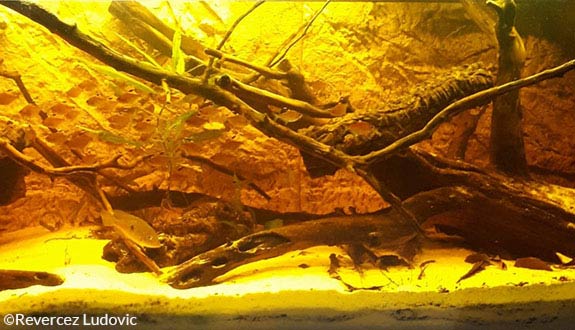
As for decoration, if you want to recreate the natural environment of the Corydoras Adolfoi and promote its well-being, create a decoration with driftwood roots that will form beautiful hiding places and do not plant too much. You can add alder fruits and dried leaves to the aquarium, which will have a nice natural effect (you will have to renew them before they rot). You can leave on a proportion of 50 to 80% of sand beaches essential for the search, 30 to 40% of wood and 10 to 20% of plants. If your fish are comfortable in your aquarium, they will not hesitate to move. A Corydoras that does not swim is a fish uncomfortable in its environment.
For plants, choose sturdy plants with slow growth and broad leaves. As fertilizer is strongly discouraged in an aquarium in Corydoras, opt for plants that do not require this type of feed.
Whatever your choices in terms of layout, still keep enough sandy beach to Corydoras so they can search the substrate.
Corydoras are quite sensitive to water pollution. Make water changes of 10 to 20% of the volume per week.
Good To know
Find all additional information!
Good To know
Find all additional information!
There are over 200 species of Corydoras! Moreover, it should be noted a risk of hybridization between Corydoras of the same line.
Corydoras are often considered "cleaners". It is true that they are scavengers but they will never replace the work of the aquarist! For example, they do not eat their excrement or those of other fish. Thus, these fish are often bought for "practical" purposes (which remains questionable) to the detriment of their welfare. But you will understand, the Corydoras are nice fish that deserve all your attention!
Corydoras rabauti has no scales, which makes it particularly sensitive to salt, chemicals and drugs. This also requires maintenance, clean water and stabilized parameters (do not introduce Corydoras in immature aquariums). IT IS NOT RECOMMENDED TO PUT FERTILIZER in a container containing Corydoras. If you notice signs of stress, such as fast breathing and then lethargy (stay still, sometimes near the surface), immediately change 50% of the water (provide a good water conditioner). Be careful, the new water must have the same parameters as the tank, including the temperature. If you isolate your sick fish, it may wilt even faster. Try to stick the hospital tray to the main aquarium so that the sick Corydoras can see its congeners.
Like all Corydoras, this species is able to swallow an air bubble on the surface. Indeed, it is a kind of "intestinal" breathing that allows the fish to supplement its oxygen supply when necessary.
Its barbels are used to search the ground for food. It is because of these «whiskers» that Corydoras are called «catfish».
Corydoras are capable of killing a human in exceptional conditions. Pay close attention to their backbones or pectorals! Depending on the species, they have hemotoxic toxins, hepatotoxic toxins, neurotoxic, etc. Did you know that they do not have a natural predator? It is thanks to this weapon with which they are able to kill their assailant in a very virulent way. Even the piranhas refuse to attack the corydoras! Here is a small zoom on their dorsal or pectoral spines:
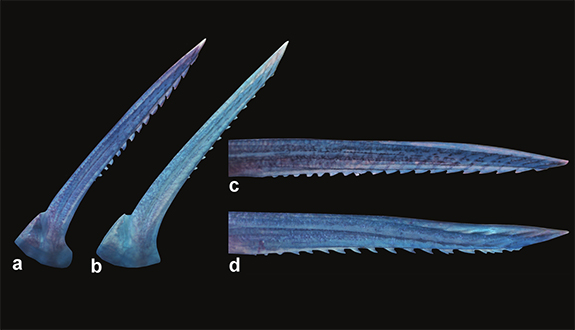
As you can see, in the case of a sting, it is impossible to remove the real sting, it’s like a real harpoon. In addition, the corydoras injects at this time a maximum dose of toxins. Rest assured, the corydoras are very much scared, so it is rare that a situation of deadly contact happens. Most of the time, they will flee for such a situation to happen. But be careful when you put your hands in the water!
Use a large mesh net to prevent stuck in it.
You will sometimes see them blink, which is quite fun for a fish!
You will sometimes come across an Albino form of this species, but this is rare. Beware of "albino" species that are more fragile. Indeed, their skin is much more sensitive than their colored cousins. They are therefore particularly vulnerable to certain drug molecules and therefore difficult to treat (if not impossible). Note that they are also very sensitive to fertilizers. In addition, unsuitable lighting (too much on the infrared or ultraviolet), which green could be good for plants, is a torture for your albino fish. It can cause redness, burns, tumors...
Corydoras rabauti is often confused with Corydoras zygatus but differs from it in its darker, more prominent black band extending to the caudal peduncle (it then bends downwards).
Yours photos!
Comments
Sort by:
Please login to post comments
